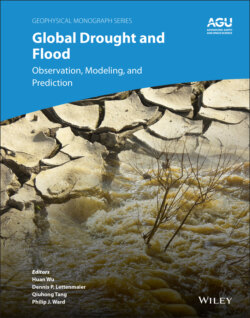Читать книгу Global Drought and Flood - Группа авторов - Страница 15
1.1. INTRODUCTION
ОглавлениеDrought is a recurring natural feature of climate and is defined as below‐normal precipitation, usually over an extended period of time (Wilhite & Buchanan‐Smith, 2005). Droughts cause billions of dollars of damage to multiple sectors globally, specifically to agriculture. Droughts may also cause, or co‐occur with, other hazards such as heatwaves, which collectively escalate the ramifications of this natural hazard (Raei et al. 2018). Indeed, the concurrence of climatic extremes, in particular droughts and heat waves, can result in forest fires (Goulden, 2018; Silva et al., 2018; Taufik et al., 2017), land degradation and desertification (Hutchinson & Herrmann, 2016; Olagunju, 2015; Vicente‐Serrano et al., 2015), water shortage for agriculture and urban water supply (AghaKouchak, Farahmand, et al., 2015; Gober et al., 2016; Khorshidi et al., 2019; Van Loon et al., 2016), and economic impacts, and may prompt water bankruptcy (Howitt et al., 2014; Madani et al., 2016). Therefore, the impacts of drought are complex and can propagate to regions outside the area of its occurrence. Drought is often categorized in four groups: meteorological, agricultural, hydrological, and socioeconomic (Dracup et al., 1980). Meteorological drought is defined as precipitation deficiency over a long period, and it best represents the onset of drought (Utah Division of Water Resources, 2007). An extended period of meteorological drought results in soil moisture deficit as evapotranspiration continues despite the lack of precipitation, which leads to agricultural drought (Cunha et al., 2015). Persistence of metrological drought ultimately reduces overall water supply and drought is manifested in a hydrological form (Modaresi Rad et al., 2016). Socioeconomic drought then occurs as supply and demand of some economic goods are impacted by meteorological, agricultural, and hydrological droughts (Shiferaw et al., 2014). The observed changes in temporal patterns of precipitation associated with unsustainable water withdrawal may escalate the drought severity around the globe (Mallakpour et al., 2018; U.S. Global Change Research Program, 2018); and large‐scale changes in weather patterns are likely to affect water storage around the globe and threaten water supply particularly in arid and semi‐arid regions (Ault et al., 2014).
Drought detection requires observation of a plethora of different climatic and biophysical variables. Observations in situ, however, do not provide a uniform spatial distribution and are limited to populated areas, hence satellite‐based observations provide a unique way to analyze and monitor drought at a global scale. Satellites offer observations for a wide range of climate variables such as precipitation, soil moisture, temperature, relative humidity, evapotranspiration, vegetation greenness, land‐cover condition, and water storage (Aghakouchak, Farahmand, et al., 2015; R. G. Allen et al., 2007; L. Wang & Qu, 2009; Whitcraft et al., 2015). Although remote sensing provides more opportunities for the scientific community to monitor Earth systems and offer better understanding of drought impact at regional to global scales, it is not without flaws or challenges. The main challenge is the insufficient length of the observed records provided for the variables of interest. Other challenges include data consistency, ease of access, quantifying uncertainty, and development of appropriate drought indices, which will be discussed throughout this chapter.
